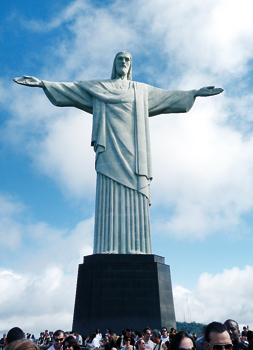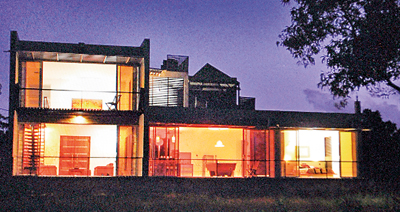Looking up in awe at a symbol of peace
The ‘Christ the Redeemer’ statue known in the local language of Portuguese as ‘Cristo Redentor’ is visible in the Rio de Janeiro skyline wherever I go in the city.

All lit up in green for the Rio+20 Earth Summit, it’s famous as one of the seven Modern Wonders of the World.
Deciding against taking an expensive taxi to the Corcovado Mountain where the landmark statue is located., my Indian colleagues and I hop a bus to the foot of the mountain although it is hard to find an English-speaking Brazilian to even explain where we are heading. But armed with a map, we show the conductor where we want to go.
On the way, the statue comes into view between buildings that block the Rio landscape. The Corcovado Mountain which means ‘camel-back’ or ‘hump’ in Portuguese due to its curved shape could possibly be the best place for Christ’s statue as its shape gives prominence to the statue on its crown.
The picturesque mountain can be conquered by vehicle or by foot; but we select the traditional Tram Car that goes up every 20 minutes to the peak. The tram car ride gives us a breathtaking view of the city and surrounding areas. The journey is also through Tijuca Forest National Park, which is a rainforest in the centre of the city. I was surprised to see trees similar to jak or kitul and this Brazilian rainforest reminds me of a forest in Sri Lanka. We are also greeted by the mischievous Capuchin monkeys that hang on the trees looking inquisitively at our tram car. Hummingbirds too could be seen hovering by flowering trees, their wings beating furiously.
When we reach the final station, there is a lift to go up, but we decide to walk the final 220 steps. On our 15 minute-walk, we see different segments of Rio de Janeiro and the buildings look like tiny match boxes. The view also includes the famous Rio beaches Copacabana, Ipanema and its famous Sugarloaf mountain.
The platform at the foot of the statue is crowded with tourists. But there is a feeling of awe when you look up from the bottom of the statue of ‘Christ the Redeemer’-a worldwide symbol of peace. The plaque mentions that it took nine years to complete this wonderful statue which is made from reinforced concrete with the outer layers being soapstone. These materials were chosen for the Rio de Janeiro statue due to their hard wearing qualities and ease to work with.
The statue is 39.6 metres (130 ft) tall including its 9.5 metre pedestal and is 30 metres (98ft) wide from fingertip to fingertip. With a weight of 635 tonnes, the Christ the Redeemer is considered the fifth largest statue of Christ in the world.
The idea of building a statue of Christ to mark the centenary of Brazil’s independence from Portugal came up in 1921. The foundation stone had been laid in 1922 and work completed in 1931 by architect Hector de Silva Costa.
Most tourists are also on a photo spree at the peak, spreading their hands like Christ in the statue. It is also fascinating to watch the photographers, who lie on the ground to capture the tall statue in the same frame as the people.


















